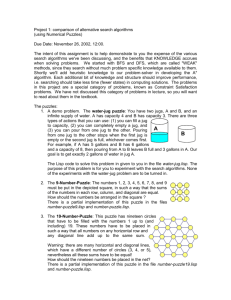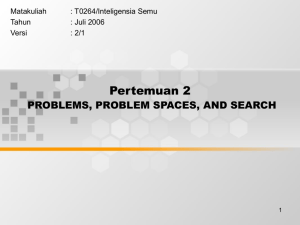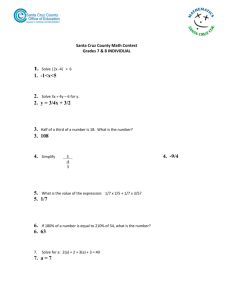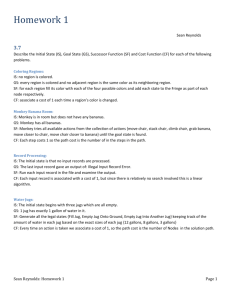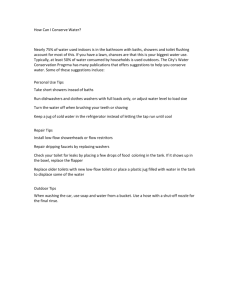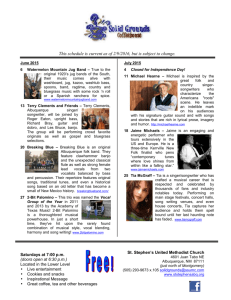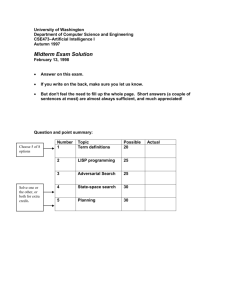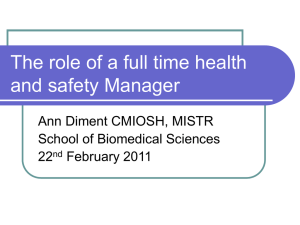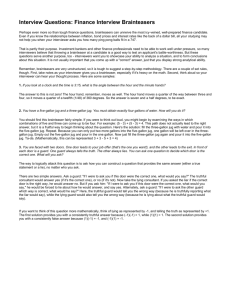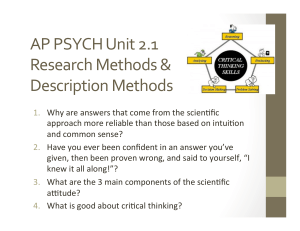solution
advertisement
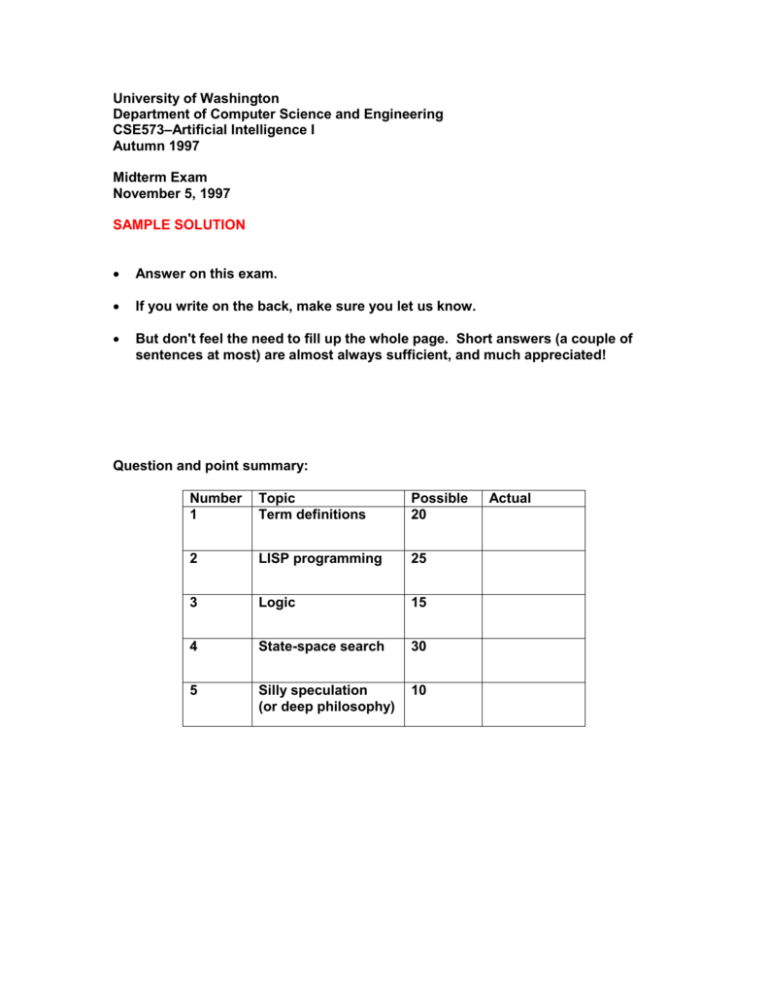
University of Washington
Department of Computer Science and Engineering
CSE573–Artificial Intelligence I
Autumn 1997
Midterm Exam
November 5, 1997
SAMPLE SOLUTION
Answer on this exam.
If you write on the back, make sure you let us know.
But don't feel the need to fill up the whole page. Short answers (a couple of
sentences at most) are almost always sufficient, and much appreciated!
Question and point summary:
Number
1
Topic
Term definitions
Possible
20
2
LISP programming
25
3
Logic
15
4
State-space search
30
5
Silly speculation
(or deep philosophy)
10
Actual
Term definitions (Answer 5 of the following; 4 points each, 20 points total)
Define the following italicized terms (short answers please; no writing on the back of the page for this
question!!)
1.
Russell and Norvig advocate studying AI from the standpoint of analyzing and/or building ideally
rational agents. (For this one, make sure you define all three terms.)
Russell and Norvig use agent to mean a program that map percepts into actions in some way, mainly to
emphasize the role of sensing and effecting (and to contrast with programs like some expert systems that
communicate only through typed text). A rational agent acts so as to maximize some performance
measure (also known as a utility function in some contexts). An ideally rational agent has no time or
memory constraints that might prevent it from computing the optimal course of action. This is in contrast
to what Simon calls type II rationality, which is acting optimally subject to processing limitations.
2.
A* search generates an optimal solution provided it is given an admissible heuristic.
A* search is an optimizing state-space search technique (it returns the minimum-cost path from initial to
goal). In A* search nodes in the search space are ranked by applying a function
f’(s) = g(s) + h’(s)
where f’ is the estimated minimum-cost path from s to a goal state. The two components are g(s) is the
actual minimum cost to get from the initial state to s, and h’(s) is the estimated minimum cost to get from s
to any goal state. A* search ranks its search frontier in ascending order of f’ values.
The “heuristic” in admissible heuristic is the h’(s) function, and it is admissible if and only if h’(s)h(s) for
all states s. If h’(s) is admissible, then the first path to a goal state detected by A* search is guaranteed to
be a minimum-cost path.
3.
Many people assert that the Turing test is the only legitimate test of machine intelligence.
The Turing test was originally posed as follows: a human investigator is seated in front of two teletype
machines. A human is on the other end of one, and a program is responding to questions typed from the
other. The teletypes were to avoid judgements based on visual cues, and also because it seemed to Turing
that speech recognition and robotic prowess were probably not essential to intelligence. The investigator
engages both agents in conversation for an unspecified amount of time and on unspecified topics (Turing
uses the weather and poetry as examples.) Eventually the investigator has to judge which of the two is the
human, and if unable to do so reliably, the machine passes the test and should be called intelligence.
Incidentally, there is an annual competition held that does exactly this. To experience the state of the art,
go to the following URL:
http://acm.org/~loebner/lpr97.html
4.
Greedy search is a particularly simple informed search method.
Russell and Norvig define a greedy search strategy in which the agent has a function f(s) = g(s) + h’(s) as
above, but ranks the states only on the basis of g(s).
5.
Breadth-first search is a complete search procedure although depth-first search is not.
A complete problem-solving algorithm is one that is guaranteed to find a solution to the problem if one
exists. (Note this definition differs from the sense in which a logic is complete.)
6.
Resolution theorem proving is a form of proof by refutation.
Proof by refutation tries to establish that a formula is entailed by a set of formulas , by attempting to
show that the set is inconsistent.
7.
Prolog databases consist only of Horn Clauses.
A Horn clause is a universally quantified implication where the left-hand side is a conjunction of 0 or more
positive atoms, and the right-hand is a single positive atom. For example:
x1, x2, …, xk. p1(x1, x2, …, xk) p2(x1, x2, …, xk) … pn(x1, x2, …, xk) q(x1, x2, …, xk)
which translates into clause form as follows:
p1(x1, x2, …, xk) p2(x1, x2, …, xk) … pn(x1, x2, …, xk) q(x1, x2, …, xk)
It is significant that there is only one positive atom in the clause form: since the current goal or subgoal to
be established will be negated, it will resolve only against the positive atom, then the other negative atoms
in the clause become subgoals to establish. This allows Prolog to pursue a relatively efficient depth-first
search for a proof.
8.
The interpretation M is a model of my axioms K
An interpretation is a semantic concept—it allows the mapping between formulas and truth values. In firstorder logic an interpretation maps constant symbols into individuals in the target domain (notice I didn’t
say “real world”), maps function symbols into target-domain functions, and predicate symbols into targetdomain relations. The definition of logical semantics then allows you to say: formula is true (or false)
relative to an interpretation M. If K is a set of formulas, interpretation M is a model of K if every formula
in K is true relative to M.
LISP Programming (25 points)
Write a function reduce, which takes two inputs: a list of objects, and a binary function defined over
pairs of elements in the list. Reduce succesively applies the function to pairs from the list and returns the
result:
(reduce '(1 2 3) '+)
(reduce '(3 4 -5) '-)
(reduce '(T T NIL T) #’(lambda (x y) (and x y)))
=> 6
=> 4
=> NIL
Do not use the Lisp primitive apply in your answer.
Use the reduce function to write a second function f which takes a list x and two numbers k and m as
inputs, and returns the value
n 1
kx
i 0
m
i
where xi are the values in the input list, which is of length n.
Two things that people tended to get wrong when defining reduce:
any function call to the input function must have two arguments (see the third example above)
the solution cannot be specific to integers (see the third example above)
(defun reduce (list fun)
(cond
((< (length list) 2)
(error “Function must be applied to two arguments.”))
((= (length list) 2)
(funcall fun (first list) (second list)))
(T (funcall fun (car list) (reduce (cdr list) fun)))))
(defun f (x k m)
(* k (reduce (mapcar #'(lambda (xx) (expt xx m)) x) '+)))
Logic (15 points)
Write axioms for the following assertions:
All Quakers are pacifist.
All Republicans are hawks.
Nobody is both a pacifist and a hawk.
Nixon is both a Quaker and a Republican.
What can you conclude about Nixon from this logical theory? Why?
x. Q(x) P(x)
x. R(x) H(x)
x. (P(x) H(x))
Q(N) R(N)
From these axioms we can derive:
P(N)
H(N)
P(N) H(N)
(P(N) H(N))
Thus there is some formula such that A├ and A├ , and by definition A is inconsistent. Since A is
inconsistent, A├ for any formula . Thus we can prove
Q(N), P(N), H(N), R(N), Q(N), P(N), H(N), R(N)
and so on.
State Space Search (30 points)
The “water jug problem” can be stated as follows: you are given two jugs, one that can hold 4 gallons of
water and the other that can hold 3 gallons of water. You also have a pump that can be used to fill either
jug with water, and you can empty the contents of either jug at any time. You goal is to get exactly 2
gallons of water into the four-gallon jug.
a. (20 points) State this problem in terms of state-space search. Describe the state, the move-generator,
the goal checker. (You can do this in Lisp if you want, or in some other computer language, or in pseudocode, or in English as long as you are precise.) Suggest a heuristic for guiding the search for a solution.
b. (10 points) Suppose that it costs $5 every time the pump is used, and $2 every time you fill the fourgallon jug, and $1 every time you use the three-gallon jug. Describe how to find the lowest-cost solution to
the problem.
To pose the search:
The state is a pair (x,y), where x is the level of the four-gallon jug and y is the level of the three-gallon
jug.
Initial state is (0,0); goal state is #'(lambda (xy) (= x 2))
Possible moves are:
FillX: x 4
FillY: y 3
EmptyX x 0
EmptyY y 0
PourXY { amount min(x, y-3); xx-amount; yy+amount }
PourYX { amount min(y, x-4); xx+amount; yy-amount }
Heuristic: turns out that a two-part control regime works pretty well:
* get rid of "nonsense pairs" like pouring into a jug then immediately emptying it
* rank (x,y) as |y-2|
To optimize the search: use A* search with a g(s) function equal to the sum of the action costs. A lowerbound estimate h(x,y) on getting from (x,y) to a goal:
if x=2, h=0
if (x+y)<2, h=7 (at least one use of the pump and one fill of x)
if (y>2), h=3 (at least one use of both jugs)
otherwise 1 (at least one use of y)
Silly Speculation (10 points)
At least once every six months on comp.ai we hear the claim that “Gödel's incompleteness theorem proves
that AI will ultimately be impossible to achieve.” Comment on this claim. What precisely is Gödel's
incompleteness theorem, and what are its claimed implications to AI according to the argument. Do you
agree or disagree with this claim?
First the easy part. Godel's incompleteness theorem says that any logical system powerful enough to
represent the natural numbers is incomplete: there is some true statement that cannot be inferred.
Equivalently, there is some formula for which neither it nor its negation can be proved.
The argument goes something like: an AI program, since it is a computer program, can be described in a
logic, and thus there is some true statement in the world that it will not be able to assert. Or to put it
another way, there will always be some "gap" in its reasoning process. Since this apparently is not true of
human intelligence, there is something inherently non-algorithmic about human reasoning, something that
machine intelligence will never be able to capture. Thus if AI's goal is to emulate human reasoning, it will
ultimately fall short.
Personally I have no strong opinion about whether there is something inherently non-algorithmic about
human reasoning, but I have never been convinced that the incompleteness result argues this point
effectively.
In any event, I think that if we believe that there is interesting work to be done on the way toward
emulating human reasoning fully, then even if we ultimately fail the journey itself will be of some value.
